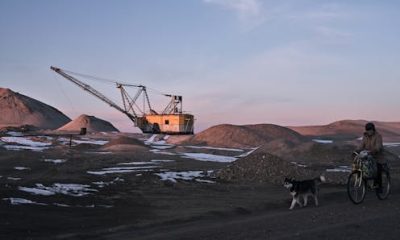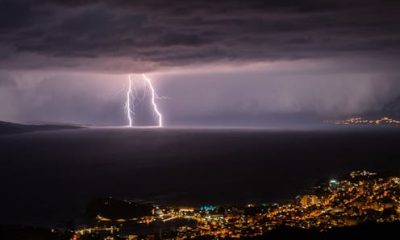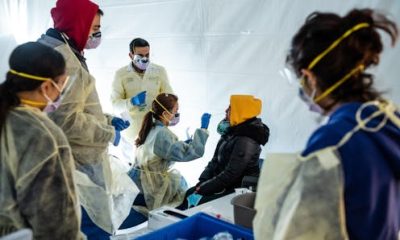
Vendors at work on a bustling Ciudad del Este street packed with stalls. Jennifer L. Tucker, CC BY-ND
Paraguay’s Ciudad del Este is a busy South American contraband hub where scrappy Paraguayan vendors and Brazilian traders mix with businessmen from places as far away as Lebanon and South Korea. This hive of activity moves billions of dollars’ worth of consumer goods – everything from smartphones to whiskey.
The city was built as a commercial hub around low taxes and tariffs, benefiting both well-to-do traders and poor workers. In its bustling main market – eight square blocks packed with street vendors, brick-and-mortar businesses and cavernous shopping galleries – thousands of Paraguayans eke out a living selling fake Gucci handbags, fishing poles and even contact lenses.
As a scholar of urban planning, I wanted to learn how this remote city of 300,000 people near South America’s spectacular Iguazu Falls blossomed into a key node along a global trade route.
I also wanted to understand the role that thousands of informal Brazilian traders and Paraguayan street vendors have played in trading systems shaped by powerful countries and corporations.
While informal markets are common, poor workers in Ciudad del Este helped build an entire city oriented around global trade. As I explain in my new book, “Outlaw Capital: Everyday Illegalities and the Making of Uneven Development,” policies aiming to legalize trade in Ciudad del Este have hurt these vendors and traders while protecting the illegal commercial activities conducted by more powerful people.
Informal work
Globally, more than 2 billion people work informally, or about 2 in every 5 people who are of working age.
Informal work includes a wide range of jobs and gigs without state recognition or benefits, like health care or retirement payments.
In Paraguay, an estimated 70% of all workers are informal.
Yet because law is biased toward formal economies, informal workers often must break rules for their livelihoods.
Stroessner’s creation
Traders, small and large, profit through arbitrage. That is, they take advantage of price differences.
To create arbitrage opportunities in Ciudad del Este, the Paraguayan government has long kept its taxes and tariffs low. This strategy, recommended by the International Monetary Fund in 1956, has promoted the legal reexportation of merchandise, where goods imported into Paraguay are speedily exported to neighbors.
Alfredo Stroessner, a brutal dictator who ruled Paraguay from 1954 to 1989, inaugurated Paraguay’s tradition of state-sanctioned smuggling. He even called it the “price of peace” because he gained allies by allocating contraband routes to potential rivals.
In the decades since Stroessner founded Ciudad del Este in 1957, a regional alliance of traders and local politicians gained control of its contraband networks. As I explain in my book, they continue to have powerful backers in the national government.
The volume of this trade is astounding, at times exceeding the country’s gross domestic product. At its peak in 2011, the value of imported goods legally reexported from Paraguay to its neighbors reached US$5 billion. The estimated value of contraband that year was twice as high: $10 billion.
Alongside contraband and legal commerce, there are also allegations of human trafficking, weapons trafficking and other criminal activity tied to Ciudad del Este.
‘Globalization from below’
Tens of thousands of Paraguayan vendors and small-scale Brazilian traders do business in Ciudad del Este. While many are poor, I found that some had gained a foothold in the middle class.
Gustavo Lins Ribeiro, a Brazilian anthropologist, argues that the city exemplifies “globalization from below” because poor workers can profit from global trade, not just international corporations. I heard one local leader call street vendors the “the lungs of Paraguay” because they draw in money from the global economy and circulate it to poor communities across the country.
By the 1990s and 2000s, thousands of independent Brazilian traders, called “sacoleiros” – a Portuguese word meaning “people hauling big bags” – crossed the Friendship Bridge into Paraguay every day. They resold fake leather jackets, linens, watches, CDs and other merchandise they bought in Ciudad del Este in street markets across Brazil.
To gather these goods, sacoleiros traveled from all over Brazil to trade in Ciudad del Este, sometimes journeying for days on buses.
Eyeing ‘notorious markets’
In the 2000s, powerful countries promoted trade liberalization and trade rule enforcement through the newly established World Trade Organization.
The U.S. government and Brazilian trade groups worried that the flow of counterfeit goods and contraband from Paraguay curbed corporate profits and harmed the U.S. economy. Since 2011, the State Department has expressed these concerns in annual reports on what it calls “notorious markets.”
The people engaged in this bustling border commerce and their advocates counter that free trade advocates write trade rules to suit their own interests.
Under pressure from the U.S., Brazil sought to curtail smuggling, but failed to distinguish between sacoleiros struggling to make a living and big-time contraband and drug runners. Instead, Brazil treated them all as dangerous criminals.
Brazilian officials cracked down on sacoleiros, enforcing laws that they had previously ignored, increasing border surveillance and confiscating sacoleiros’ merchandise in raids, and casting them into debt.
This pushed informal traders onto riskier routes, like the networks of clandestine ports along the Parana River and Lake Itaipu, which they need to navigate with small wooden skiffs.
Brazilians carrying goods bought in Ciudad del Este approach the Friendship Bridge, which links the Paraguayan city with Foz do Iguacu, Brazil, in 2010.
Norberto Duarte/AFP via Getty Images
Formalizing sacoleiros
As Brazil criminalized sacoleiros, these informal workers fought for policies that would protect their livelihoods.
A Brazil-Paraguay plan called the Unified Trade Regime – Régimen de Tributo Unificado in Spanish – sought to integrate the sacoleiros into the formal economy and transform them into “micro-entrepreneurs.”
In the new system, registered sacoleiros pay lower taxes on specific consumer goods purchased from registered shops and tracked through an electronic system. The system was designed to differentiate between two flows of goods sold to foreigners: merchandise purchased by bargain-hunting tourists for their own use, and items sacoleiros buy in bulk in Paraguay to sell across the border in Brazil.
Before this system took effect, all visitors could buy merchandise duty-free up to an official limit that fluctuated between $150 and $500.
Despite U.S. attempts to sink the plan, it went into effect in 2012; afterward, only registered businesses could participate in the Unified Trade Regime.
Informal street vendors could not meet these requirements, and were excluded.
Another glitch: Negotiators ignored research recommending a total tax rate of no more than 22%, so as to make smuggling not worth the costs and risks, I learned from a Paraguayan official. Instead, they set the total tax rate at 25%.
Few businesses registered, and the plan faltered.
While the U.S. opposed formalizing sacoleiros, the U.S. Agency of International Development funded the research behind a similar plan to formalize trade in the electronic goods sold by more affluent businesses. I found this plan reduced their tax burden to just over 5%.
Differential treatment for informal workers and wealthy traders reflects an imbalance in their negotiating power. I also argue it reflects common biases against informal workers and their economic realities.
Protecting some illegal transactions
Yet state officials protected some illegal arrangements, like ex-President Horacio Cartes’ contraband cigarette trade. Despite multiple international complaints, political pacts protected the clandestine networks transporting his cigarettes to regional markets.
Informal economies can provide livelihood for the millions excluded from formal work, enliven cities and provide important urban services. I believe efforts to force everyone to follow the rules must be matched by a commitment to protect the livelihoods of poor workers.
Jennifer L. Tucker received funding from the Fulbright Program, the Social Science Research Council, the Berkeley Center for Latin American and Caribbean Studies and the School of Architecture and Planning at the University of New Mexico
Advertisement

Advertisement
Contact Us
If you would like to place dofollow backlinks in our website or paid content reach out to info@qhubonews.com











